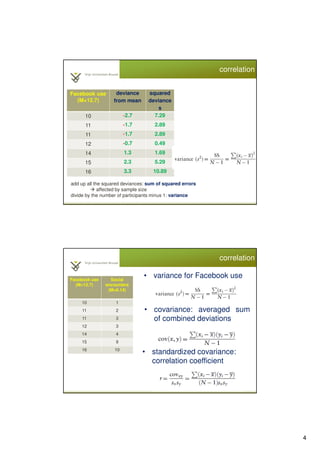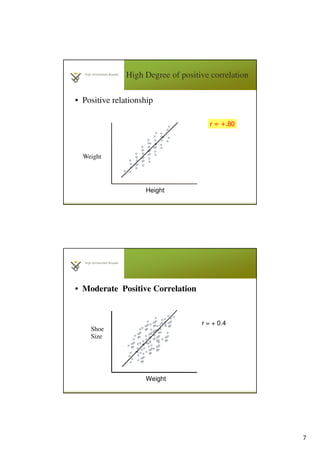Applied statistics lecture_4
- 1. 1 Introduction to applied statistics & applied statistical methods Prof. Dr. Chang Zhu1 objectives • significance p-value • Paired sample t-test • Mann Whitney tests • correlation Pearson’s r Spearman’s rho (rs) Kendall’s tau-b (τ) Partial correlation
- 2. 2 significance – p value value test statistic alternative hypothesis null hypothesis p < .05 significant accepted rejected p > .05 non-significant rejected accepted significance – p value For t-tests • p < .05 the difference is proved to be significant. • Look at the means of the two groups before making decision about the direction of the hypothesis, i.e. which group has a higher/bigger mean?
- 3. 3 correlation • A researcher is interested in the degree to which a person spends time Facebooking (in hours per week) and the amount of time spent socialising with friends (number of social encounters per month). • He comes up with the following data set. (adapted from http://wps.pearsoned.co.uk/ema_uk_he_dancey_statsmath _4/84/21626/5536329.cw/index.html) P_ID Facebook use Social encounters 1 10 1 2 11 2 3 11 3 4 12 3 5 14 4 6 15 9 7 16 10 correlation What can you predict?
- 4. 4 Facebook use (M=12.7) deviance from mean squared deviance s 10 -2.7 7.29 11 -1.7 2.89 11 -1.7 2.89 12 -0.7 0.49 14 1.3 1.69 15 2.3 5.29 16 3.3 10.89 correlation add up all the squared deviances: sum of squared errors affected by sample size divide by the number of participants minus 1: variance Facebook use (M=12.7) Social encounters (M=6.14) 10 1 11 2 11 3 12 3 14 4 15 9 16 10 correlation • variance for Facebook use • covariance: averaged sum of combined deviations • standardized covariance: correlation coefficient
- 5. 5 correlation SPSS output Correlations FB Encounters FB Pearson Correlation 1 .900** Sig. (2-tailed) .006 N 7 7 Encounters Pearson Correlation .900** 1 Sig. (2-tailed) .006 N 7 7 **. Correlation is significant at the 0.01 level (2-tailed). r = .90, p < .01 (significant) Correlation Positive Correlation Negative Correlation Correlation analysis
- 6. 6 correlation The correlation coefficient: measures the relative strength of the linear relationship between two variables • Ranges between –1 and 1 • The closer to –1, the stronger the negative linear relationship • The closer to 1, the stronger the positive linear relationship • The closer to 0, the weaker any positive linear relationship A perfect positive correlation Height Weight Height of A Weight of A Height of B Weight of B A linear relationship
- 7. 7 High Degree of positive correlation • Positive relationship Height Weight r = +.80 • Moderate Positive Correlation Weight Shoe Size r = + 0.4
- 8. 8 • Perfect Negative Correlation Exam score TV watching per week r = -1.0 • Moderate Negative Correlation Exam score TV watching per week r = -.80
- 9. 9 • Weak negative Correlation Weight Shoe Size r = - 0.2 • No Correlation (horizontal line) Height IQ r = 0.0
- 10. 10 Test of Correlations Parametric test: Pearson’s r is the most common correlation coefficient. Non-parametric tests • Spearman’s rho (rs): rank the scores, then use the same equation as above. • Kendall’s tau-b (τ) : taking into account tied ranks. PRACTICE
- 11. 11 Practice 1 Pearson’s correlation •We collect the scores of 200 high school students on various tests, including science, reading, and maths score, and we want to know if there is a correlation between the scores of each pair of the variables. •The data file is named test_score.sav In SPSS, choose Analyse > Correlate > Bivariate practical guidelines page 2 SPSS output Correlations reading score math score science score reading score Pearson Correlation 1 .662** .630** Sig. (2-tailed) .000 .000 N 200 200 200 math score Pearson Correlation .662** 1 .631** Sig. (2-tailed) .000 .000 N 200 200 200 science score Pearson Correlation .630** .631** 1 Sig. (2-tailed) .000 .000 N 200 200 200 **. Correlation is significant at the 0.01 level (2-tailed).
- 12. 12 Practice 1 Conclusion? Reading scores were significantly correlated with math scores, r = .66, p < .01 (one-tailed), and science scores, r = .63, p < .01 (one-tailed); the math scores were also correlated with the science scores, r = .63, p < .01 (one-tailed). (Practical guidelines page 4) Practice 2 Partial correlation • Use the data file Exam Anxiety.sav • Conduct the Pearson’s correlation for the three variables: exam, anxiety, and revise • What is the relationship between the variable anxiety and exam and revise In SPSS, choose Analyse > Correlate > Bivariate
- 13. 13 SPSS output Correlations Time Spent Revising Exam Performance (%) Exam Anxiety Time Spent Revising Pearson Correlation 1 .397** -.709** Sig. (2-tailed) .000 .000 N 103 103 103 Exam Performance (%) Pearson Correlation .397** 1 -.441** Sig. (2-tailed) .000 .000 N 103 103 103 Exam Anxiety Pearson Correlation -.709** -.441** 1 Sig. (2-tailed) .000 .000 N 103 103 103 **. Correlation is significant at the 0.01 level (2-tailed). Practice 2 Partial correlation Observation: • Exam anxiety is negatively correlated with exam performance (r = -.441) • Exam anxiety is also negatively correlated with the time spent revising (revision time) for the exam (r = -.709) • However, exam performance is positively related to the time spent revising (r= .397)
- 14. 14 Practice 2 Partial correlation • The revision time may affect the relationship between exam anxiety and exam performance such that the more one spends time on revision, the less anxiety one perceives, hence better performance. • We are capable of investigating purely the relationship between exam anxiety and exam performance, taking into account the effect of time spent on revising. In SPSS, choose Analyse > Correlate > Partial SPSS output Correlations Control Variables Exam Performance (%) Exam Anxiety Time Spent Revising Exam Performance (%) Correlation 1.000 -.247 Significance (2- tailed) . .012 df 0 100 Exam Anxiety Correlation -.247 1.000 Significance (2- tailed) .012 . df 100 0 not controlling for time spent revising: r = -.441
- 15. 15 Practice 2 Partial correlation Conclusion? Exam anxiety was significantly related to exam performance, r = -.247, p < .05 (two-tailed), controlling for the effect of time spent on revising. (Practical guidelines page 4) Practice 1 •Two examiners rated the presentations of 20 students with 1 being poor and 10 meaning perfect. It is expected that the scores would be similar. •The data file is named presentation_rating.sav. (Practical guidelines page 6) Practice 3 Spearman and Kendall’s tau (nonparametric) In SPSS, choose Analyse > Correlate > Bivariate
- 16. 16 Practice 3 Spearman and Kendall’s tau (nonparametric) Conclusion? •The rating of the two examiners was significantly correlated, rs = .825, p < .01 (one-tailed). Or: •The rating of the two examiners was significantly correlated, τ = .707, p < .01 (one-tailed) (Practical guidelines page 6) Assignment • Conduct paired t-test • Conduct Mann Whitney tests • Conduct correlation analysis
















